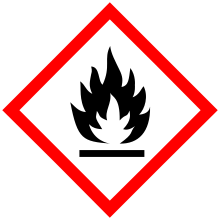
Back اشتعالية Arabic Entflommboakeit BAR Zapaljivost BS Inflamabilitat Catalan Hořlavina Czech Fflamadwyedd Welsh Entflammbarkeit German Ευφλεκτότητα Greek Combustibilidad e inflamabilidad Spanish Sukoitasun Basque




A combustible material is a material that can burn (i.e., sustain a flame) in air under certain conditions. A material is flammable if it ignites easily at ambient temperatures. In other words, a combustible material ignites with some effort and a flammable material catches fire immediately on exposure to flame.
The degree of flammability in air depends largely upon the volatility of the material – this is related to its composition-specific vapour pressure, which is temperature dependent. The quantity of vapour produced can be enhanced by increasing the surface area of the material forming a mist or dust. Take wood as an example. Finely divided wood dust can undergo explosive flames and produce a blast wave. A piece of paper (made from wood) catches on fire quite easily. A heavy oak desk is much harder to ignite, even though the wood fibre is the same in all three materials.
Common sense (and indeed scientific consensus until the mid-1700s) would seem to suggest that material "disappears" when burned, as only the ash is left. Further scientific research has found that conservation of mass holds for chemical reactions. Antoine Lavoisier, one of the pioneers in these early insights, stated: "Nothing is lost, nothing is created, everything is transformed." The burning of a solid material may appear to lose weight if the mass of combustion gases (such as carbon dioxide and water vapor) are not taken into account. The original mass of flammable material and the mass of the oxygen consumed (typically from the surrounding air) equals the mass of the flame products (ash, water, carbon dioxide, and other gases). Lavoisier used the experimental fact that some metals gained mass when they burned to support his ideas (because those chemical reactions capture oxygen atoms into solid compounds rather than gaseous water).